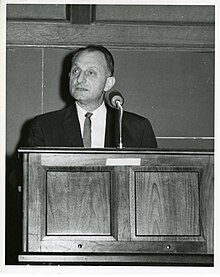


Samuel Nathan Alexander (February 22, 1910 in Wharton, Texas – December 9, 1967 in Chevy Chase, Maryland) was an American computer pioneer who developed SEAC, one of the earliest computers.



Samuel Nathan Alexander (February 22, 1910 in Wharton, Texas – December 9, 1967 in Chevy Chase, Maryland) was an American computer pioneer who developed SEAC, one of the earliest computers.
Alexander studied at the University of Oklahoma, earning a bachelor's degree in 1931 and at the Massachusetts Institute of Technology with a master's degree in 1933. After that, he was an engineer in the laboratory of Simplex, Wire and Cable Company, worked in the electronic instrument development for the U.S. Navy and was Senior Project Engineer at the Bendix Aviation Corporation. In 1946 he went to the National Bureau of Standards, where he became head of the Laboratory of electronic computer until 1954, when he became head of the data processing department. From 1964 to his death in 1967 he headed the Department of Information Technology. Alexander assisted Margaret R. Fox in developing a series of college computer courses beginning in 1966. [1]
At the National Bureau of Standards in Washington, he developed the SEAC computer (Standards Eastern Automatic Computer). [2] [3] At first this was named National Bureau of Standards (NBS) Interim Computer. It was one of many computers built at that time along the lines of John von Neumann's design in universities, laboratories and government organizations, but were only intended as an interim solution until the industry could provide better computer. In this case, they were waiting for a computer by UNIVAC (Alexander was also involved in its design), whose delivery had been delayed. Alexander's chief architect was Ralph J. Slutz (1917-2005) who previously worked with John von Neumann to build a computer at the Institute for Advanced Study. [4]
The SEAC was the first fully functional electronic computer with internal program memory (stored program) in the U.S. it also was the first computer with semiconductor logic (first 10,500, then 16,000 germanium diodes), in addition to the 747 and later 1600 vacuum tubes. The computer operated for 14 years and was originally intended for training purposes within government agencies, but some of the earliest assemblers and compilers were built for it. [5] It was the fastest fully functional computer for about a year until the UNIVAC I came out in 1951. It also served as a model for other government computers e.g. with the National Security Agency.
Alexander also initiated the prototype DYSEAC at the NBS, a successor to the SEAC, which was built for the US Signal Corps. It was delivered in 1954 and could be transported in a truck.
He was an advisor to the US government and, in 1956 to Sweden and, in 1957, India.
In 1967 he received the Harry H. Goode Memorial Award [6] and the 1981 Computer Pioneer Award from the IEEE Computer Society. He was a member of the Washington Academy of Sciences.

The history of computing hardware covers the developments from early simple devices to aid calculation to modern day computers.
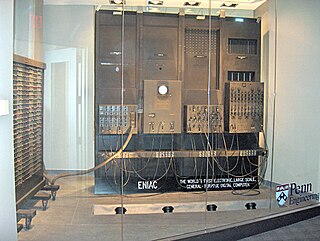
ENIAC was the first programmable, electronic, general-purpose digital computer, completed in 1945. There were other computers that had combinations of these features, but the ENIAC had all of them in one computer. It was Turing-complete and able to solve "a large class of numerical problems" through reprogramming.
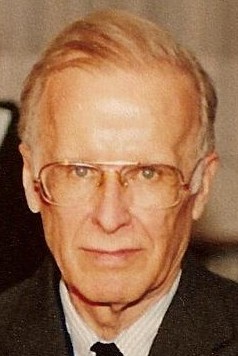
John Warner Backus was an American computer scientist. He directed the team that invented and implemented FORTRAN, the first widely used high-level programming language, and was the inventor of the Backus–Naur form (BNF), a widely used notation to define formal language syntax. He later did research into the function-level programming paradigm, presenting his findings in his influential 1977 Turing Award lecture "Can Programming Be Liberated from the von Neumann Style?"

John Adam Presper Eckert Jr. was an American electrical engineer and computer pioneer. With John Mauchly, he designed the first general-purpose electronic digital computer (ENIAC), presented the first course in computing topics, founded the Eckert–Mauchly Computer Corporation, and designed the first commercial computer in the U.S., the UNIVAC, which incorporated Eckert's invention of the mercury delay-line memory.
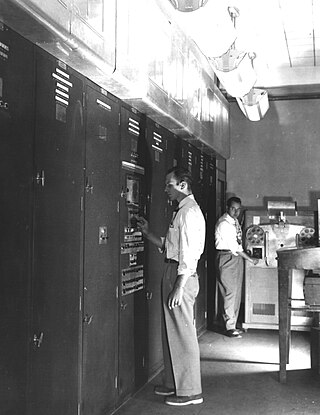
EDVAC was one of the earliest electronic computers. It was built by Moore School of Electrical Engineering, Pennsylvania. Along with ORDVAC, it was a successor to the ENIAC. Unlike ENIAC, it was binary rather than decimal, and was designed to be a stored-program computer.

John William Mauchly was an American physicist who, along with J. Presper Eckert, designed ENIAC, the first general-purpose electronic digital computer, as well as EDVAC, BINAC and UNIVAC I, the first commercial computer made in the United States.

The UNIVAC I was the first general-purpose electronic digital computer design for business application produced in the United States. It was designed principally by J. Presper Eckert and John Mauchly, the inventors of the ENIAC. Design work was started by their company, Eckert–Mauchly Computer Corporation (EMCC), and was completed after the company had been acquired by Remington Rand. In the years before successor models of the UNIVAC I appeared, the machine was simply known as "the UNIVAC".

UNIVAC was a line of electronic digital stored-program computers starting with the products of the Eckert–Mauchly Computer Corporation. Later the name was applied to a division of the Remington Rand company and successor organizations.
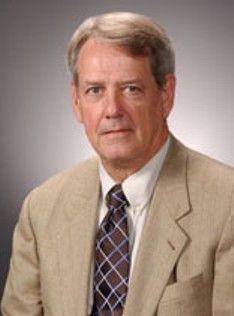
James Sacra Albus was an American engineer, Senior NIST Fellow and founder and former chief of the Intelligent Systems Division of the Manufacturing Engineering Laboratory at the National Institute of Standards and Technology (NIST).
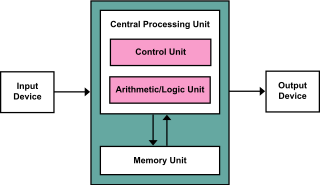
The von Neumann architecture—also known as the von Neumann model or Princeton architecture—is a computer architecture based on a 1945 description by John von Neumann, and by others, in the First Draft of a Report on the EDVAC. The document describes a design architecture for an electronic digital computer with these components:
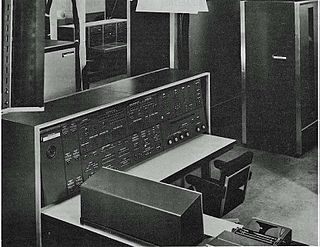
The UNIVAC LARC, short for the Livermore Advanced Research Computer, is a mainframe computer designed to a requirement published by Edward Teller in order to run hydrodynamic simulations for nuclear weapon design. It was one of the earliest supercomputers.
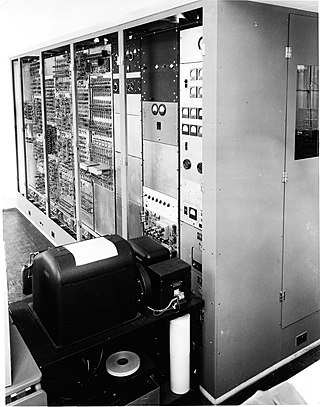
SEAC was a first-generation electronic computer, built in 1950 by the U.S. National Bureau of Standards (NBS) and was initially called the National Bureau of Standards Interim Computer, because it was a small-scale computer designed to be built quickly and put into operation while the NBS waited for more powerful computers to be completed. The team that developed SEAC was organized by Samuel N. Alexander. SEAC was demonstrated in April 1950 and was dedicated in June 1950; it is claimed to be the first fully operational stored-program electronic computer in the US.
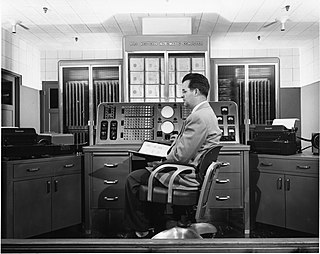
The SWAC was an early electronic digital computer built in 1950 by the U.S. National Bureau of Standards (NBS) in Los Angeles, California. It was designed by Harry Huskey.

DYSEAC was the second Standards Electronic Automatic Computer.
The Eckert–Mauchly Computer Corporation (EMCC) was founded by J. Presper Eckert and John Mauchly. It was incorporated on December 22, 1947. After building the ENIAC at the University of Pennsylvania, Eckert and Mauchly formed EMCC to build new computer designs for commercial and military applications. The company was initially called the Electronic Control Company, changing its name to Eckert–Mauchly Computer Corporation when it was incorporated. In 1950, the company was sold to Remington Rand, which later merged with Sperry Corporation to become Sperry Rand, and survives today as Unisys.

Frances Elizabeth Holberton was an American computer scientist who was one of the six original programmers of the first general-purpose electronic digital computer, ENIAC. The other five ENIAC programmers were Jean Bartik, Ruth Teitelbaum, Kathleen Antonelli, Marlyn Meltzer, and Frances Spence.
Theory and Techniques for Design of Electronic Digital Computers was a course in the construction of electronic digital computers held at the University of Pennsylvania's Moore School of Electrical Engineering between July 8, 1946, and August 30, 1946, and was the first time any computer topics had ever been taught to an assemblage of people. The course disseminated the ideas developed for the EDVAC and initiated an explosion of computer construction activity in the United States and internationally, especially in the United Kingdom.

Cuthbert Corwin Hurd was an American computer scientist and entrepreneur, who was instrumental in helping the International Business Machines Corporation develop its first general-purpose computers.
Samuel Lubkin (1906-1972) was a mathematician and computer scientist instrumental in the early history of computing.